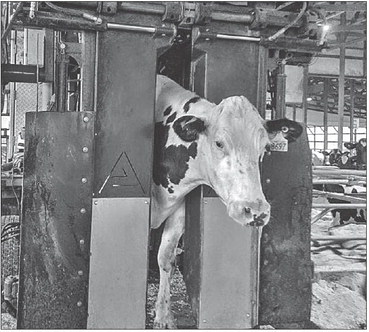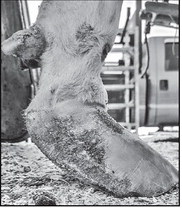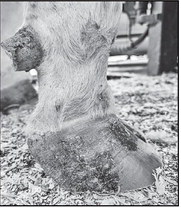Hooves are his business


By Valorie Brecht
In a rural community where dairy farming is a way of life, keeping cows in shape from head to hoof is critical for their overall well-being and milk production.
That is where a business like Brubacker’s Hoof Care comes in.
Steven Brubacker lives in rural Spencer and spends his days visiting Central Wisconsin’s many dairy farms, with the occasional longer trip, to complete about 20,000 hoof trims a year. He enjoys getting to work with different animals every day.
“If you work around animals, your life usually isn’t boring. They keep it interesting; that’s for sure,” he said.
Steven is in the process of buying the business from his father, David. He is wellversed in all aspects of the business from being a part of it for about 15 years. Although he did not grow up on a farm, he has many relatives that farm, and from a young age, he would ride along with his dad on the weekends when he would go to trim cows’ hooves. In the fall of 2014, Steven started working with his dad fulltime.
Steven’s grandpa started the business. Back in his time, he used basic hand tools, nippers, and knives. He had a tilt table built specifically for the business to turn cows on their side.
Now, Steven uses a professional hoof trimming chute from Appleton Steel. The cow remains standing the entire time, but there are several guides that hold the cow in place. Cows are funneled into a single file line. When a cow enters the chute, a rear sorting gate closes to prevent the next cow from entering. The cow’s head goes in a head gate and a strap underneath the chest supports the cow. Metal plates also swing in behind the cow. After the cow is secure, the entire platform is raised using a hydraulic system. The leg is secured with a metal clamp and lifted into position so the hoof trimmer has easy access to the hoof.
Steven grinds down the front hooves while his coworker, Timothy Weaver, tackles the back. They use 12,000-RPM De-Walt angle grinders with carbide inserts. They also use knives if needed for greater precision. Each cow typically takes no longer than two minutes to have its hooves trimmed, except if it needs a “therapeutic” trim to treat an injury or issue such as ulcers or warts. Steven or Timothy may wrap the hoof to protect it while it heals.
Cows typically have their hooves trimmed two or three times a year.
“It depends on the environment,” Steven said. “A cow’s natural environment is in a pasture, so you might be able to get away with once a year. But a lot of free-stall barns, we’re looking at every four to six months, or roughly three times per lactation. So we’ll probably do it sometime when she’s in her dry period and then twice when she’s in her milking period.”
Steven puts in 40-50 hours a week, working six days a week. He completes roughly 80 cows a day. Most of his customers are within a 50-mile radius of his home, although he does have a few in the southwestern part of the state.
He is passionate about helping his customers maintain their cows’ hoof health. Excess hoof growth could lead to lameness and permanently impaired motion, potentially leading to premature death.
“A cow with a sore foot won’t walk as
See BRUBACKER/ page 13
COW CUSTOMER - A cow takes its turn inside Steven Brubacker’s trimming chute, which is used to hold the animal still while its hooves are safely trimmed. The trimming has a come a long way since his grandfather started doing it.
SUBMITTED PHOTO Brubacker
Continued from page 12
much, won’t ruminate as much, and produce as much milk. So, hoof health is very important,” said Steven.
He considers himself part of an animal health team, including the veterinarian, nutritionist, and herdsman, who are all working to achieve the best health outcomes for the dairy cattle.
In order to be the best trimmer he can be, Steven has taken advantage of several educational opportunities. He attended Midwestern Hoof Trimming School, which is a weeklong course which dives into the internal components of the hoof structure.
There are two schools in Wisconsin — in Baraboo and Green Bay. Steven completed his schooling back around 2016 or 2017. He also attends annual professional conferences of the Hoof Trimmers Association, which includes members from 38 U.S. states, nine Canadian provinces, and more than 15 countries.
These conferences give him the opportunity to network with other hoof trimmers from across the country and world.
“I’m always looking for ways to improve foot health in general,” he said. “There has been some real good improvement made over the last several years. Researchers are always doing new studies and learning more about hoof care. You can never know everything; you always want to keep learning.”
Although he enjoys the job and finds it rewarding, Steven also recognizes the job comes with inherent challenges, not the least of which is the risk of injury that comes with working with large animals and power tools.
“You’ve got to be really careful. A lot of people in the business have lost fingers because the cow flinched a little bit,” said Steven.
The hoof trimmer also never knows exactly how the cow will behave, as it’s an animal with a mind of its own.
“There are challenges every day, working with difficult cows.... You try to keep kicks at a minimum, but it does happen still. It’s a challenge working with animals,” he said. “If they get you in a comer, or you turn around in a tight spot, you can get crushed pretty easily. You gotta watch their legs; you don’t want to get kicked.”
“I’ve actually been really lucky,” he added. “I’ve never really had a serious injury. The worst injury I had from a cow kicking me would be soon after I started trimming: a cow had kicked me and it put my back out of place. But it’s something I just deal with. It’s one of the risks that comes with working with bigger animals like that.”
The job also takes a physical toll due to the repetitive nature of the movements.
“A lot of older trimmers will develop caipal tunnel or different aches and pains, especially wrist pain,” said Steven.
For now, though, Steven is content with his job and plans to continue offering this crucial service to local farms. He finds satisfaction in doing a good quality job.
“I enjoy being outside eveiy day. And, there’s definitely an art to being a good hoof trimmer. You’re working with pretty slim margins. The more experienced you are, the more precise you can be. But that’s what I like about the job. I’m kind of a perfectionist; I like things just right. So it’s satisfying to be able to take a hoof and make improvements so they will balance better and walk better.”
Steven resides near Riplinger with his wife Carolyn, and their daughter, Marina, 1.5 years old.
For more information on Brubacker’s Hoof Care, call Steven at 715-316-8209. If he is not available, feel free to leave a message and he’ll return your call.
BEFORE AND AFTER - The picture at left shows a cow’s hoof before it has been trimmed by Steven Brubacker, while the one on the right shows a freshly shaved hoof. Cows need to have their hooves trimmed two or three times a year in order to stay healthy and comfortable.
SUBMITTED PHOTOS


